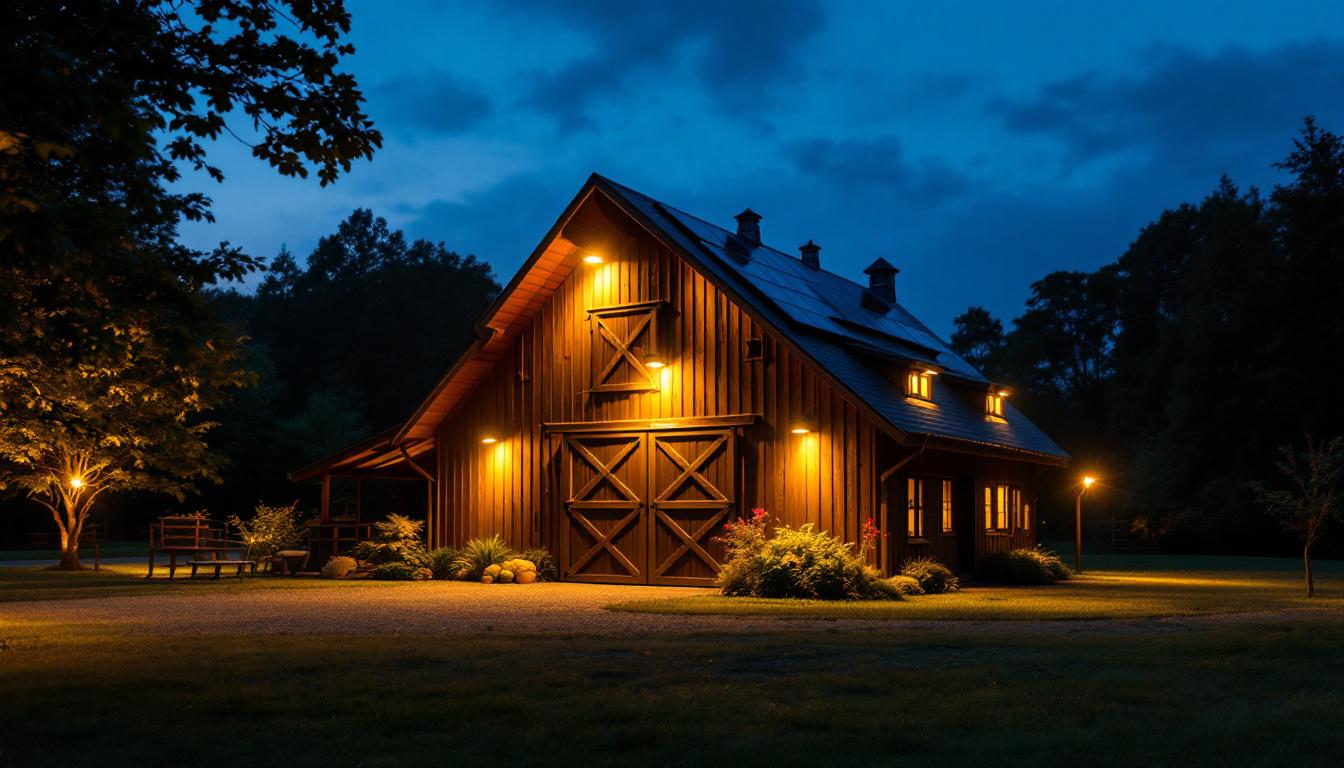
As the demand for sustainable and energy-efficient solutions continues to rise, solar power has emerged as a viable option for various applications, including barn lighting. Lighting contractors often encounter questions regarding the implementation and benefits of solar-powered barn lights. This article aims to address common queries and provide insights into the advantages and considerations of using solar energy for barn lighting.
Solar-powered barn lights utilize solar panels to convert sunlight into electricity, which powers LED lights. These systems are typically equipped with batteries that store energy for use during nighttime or cloudy days. This technology not only reduces electricity costs but also minimizes the environmental impact associated with traditional lighting solutions.
In rural areas where access to the electrical grid may be limited or non-existent, solar-powered barn lights offer an effective solution. They can be installed in various locations without the need for extensive wiring or infrastructure, making them an attractive option for many farmers and ranchers.
The operation of solar barn lights is relatively straightforward. During the day, solar panels capture sunlight and convert it into electrical energy. This energy is used to charge batteries, which store the power for later use. At dusk, the lights automatically turn on, drawing energy from the batteries to illuminate the barn and surrounding areas.
Most solar barn lighting systems come with built-in sensors that detect ambient light levels, ensuring that the lights operate efficiently. Some models may also feature timers or motion sensors, allowing for even greater control over lighting schedules and energy consumption.
There are several advantages to using solar power for barn lighting. Firstly, the most significant benefit is the reduction in electricity costs. Since solar lights operate independently of the electrical grid, they eliminate monthly utility bills associated with traditional lighting.
Additionally, solar barn lights contribute to sustainability efforts. By harnessing renewable energy, they help reduce carbon footprints and promote environmentally friendly practices. This can enhance the reputation of farms and businesses committed to sustainability.
When installing solar barn lights, several factors must be taken into account to ensure optimal performance. The first consideration is the location of the solar panels. Ideally, they should be placed in an area that receives direct sunlight for the majority of the day. Any shading from trees, buildings, or other structures can significantly reduce the efficiency of the solar panels.
Another important factor is the orientation of the solar panels. They should be angled to maximize exposure to sunlight throughout the day. Proper installation not only enhances energy capture but also prolongs the lifespan of the solar lighting system.
The number of solar lights required for a barn depends on various factors, including the size of the barn, the desired brightness, and the specific lighting needs. A lighting contractor should conduct a thorough assessment of the space to determine the optimal number of fixtures.
In general, it is advisable to space solar lights evenly to ensure consistent illumination. For larger barns, multiple fixtures may be necessary to cover all areas adequately. Additionally, contractors should consider the wattage of the lights, as higher wattage can provide more brightness but may also require more solar panels and battery capacity.
One of the appealing aspects of solar barn lights is their low maintenance requirements. However, regular upkeep is still essential to ensure longevity and efficiency. Periodic cleaning of the solar panels is necessary to remove dirt, dust, and debris that can obstruct sunlight and reduce energy capture.
It is also important to check the batteries and connections to ensure they are functioning correctly. Over time, batteries may need to be replaced, especially if they show signs of diminished performance. By conducting routine inspections, contractors can help maintain the system’s efficiency and extend its lifespan.
The initial investment for solar barn lights can vary widely based on factors such as the type of lights selected, the number of fixtures, and the complexity of the installation. While the upfront cost may be higher than traditional lighting systems, it is essential to consider the long-term savings on electricity bills and maintenance costs.
Many manufacturers offer a range of solar lighting options, from basic models to more advanced systems with features like motion sensors and remote control. Lighting contractors should work with clients to assess their needs and budget, helping them choose the best option for their specific situation.
In many regions, there are incentives or rebates available for the installation of solar energy systems, including solar barn lights. These programs can significantly offset the initial investment and make solar lighting a more attractive option for farmers and ranchers.
Contractors should stay informed about local, state, and federal incentives that may apply to their clients. This information can be valuable in discussions about the benefits of solar lighting and can help clients make informed decisions about their investments.
When comparing the cost of solar barn lights to traditional lighting solutions, it is important to consider both the upfront and ongoing expenses. Traditional lighting systems often require a significant investment in wiring, installation, and ongoing electricity costs, which can add up over time.
In contrast, while solar lighting may have a higher initial cost, it typically results in lower long-term expenses. With no electricity bills and minimal maintenance requirements, solar barn lights can provide significant savings over their lifespan. Additionally, the increasing efficiency of solar technology continues to drive down costs, making solar lighting an increasingly competitive option.
A common misconception is that solar lights do not provide sufficient brightness for practical use in barns. However, advancements in LED technology have significantly improved the brightness and efficiency of solar-powered lights. Many solar barn lights are now capable of delivering adequate illumination for various tasks, from feeding animals to performing maintenance work.
Contractors can help dispel this myth by showcasing the capabilities of modern solar lighting systems. By selecting high-quality fixtures with appropriate wattage, it is possible to achieve the desired brightness for any barn application.
Another frequent concern is the performance of solar lights during inclement weather. While solar lights do rely on sunlight for energy, many systems are designed to store enough energy in their batteries to operate even on cloudy or rainy days. The duration of operation may vary depending on the amount of sunlight received, but most systems can provide reliable lighting even in less-than-ideal conditions.
It is also worth noting that solar panels can still generate electricity on cloudy days, albeit at a reduced capacity. This means that with proper battery storage, solar barn lights can remain functional throughout varying weather conditions.
Some contractors may believe that solar barn lights are complicated to install. However, many solar lighting systems are designed for easy installation, often requiring no specialized skills or tools. Most systems come with clear instructions, and the absence of wiring makes the process straightforward.
For lighting contractors, this simplicity can be a selling point. By emphasizing the ease of installation, contractors can encourage clients to consider solar options without the fear of a complicated setup process.
The field of solar technology is continually evolving, with new innovations emerging that promise to enhance the efficiency and functionality of solar barn lights. One trend gaining traction is the integration of smart technology, allowing users to control lighting remotely via smartphones or other devices.
Additionally, advancements in battery technology are expected to improve energy storage capabilities, enabling solar lights to operate for longer periods without direct sunlight. These innovations will further enhance the appeal of solar barn lights, making them an even more attractive option for lighting contractors and their clients.
As the push for renewable energy continues, regulations surrounding solar energy usage are likely to evolve. Lighting contractors should stay informed about potential changes in legislation that could impact the installation and use of solar barn lights.
Increased support for renewable energy initiatives may lead to more incentives and funding opportunities for solar projects. This could create a favorable environment for contractors to promote solar lighting solutions to their clients, further driving adoption in the agricultural sector.
As sustainable farming practices gain prominence, solar barn lights will likely play a crucial role in reducing the environmental impact of agricultural operations. By utilizing renewable energy sources, farmers can decrease their reliance on fossil fuels and contribute to a greener future.
Lighting contractors have the opportunity to be at the forefront of this movement, providing solutions that align with the values of sustainability and environmental responsibility. By offering solar barn lighting options, they can help farmers achieve their sustainability goals while also enhancing the functionality of their operations.
Solar power presents a compelling solution for barn lighting, offering numerous benefits for lighting contractors and their clients. By addressing common questions and misconceptions, contractors can better inform their clients about the advantages of solar barn lights and guide them in making informed decisions.
As technology continues to advance and the demand for sustainable solutions grows, solar barn lights are poised to become an increasingly popular choice in the agricultural sector. By embracing this trend, lighting contractors can not only enhance their service offerings but also contribute to a more sustainable future for farming and ranching operations.
Ready to harness the power of the sun for your next barn lighting project? Look no further than LumenWholesale for all your solar lighting needs. Our selection of spec-grade lighting products offers the quality and performance you demand, at wholesale prices that can’t be beaten. Say goodbye to middleman markups and hello to hassle-free bulk buying with free shipping. Elevate your lighting solutions with the confidence that you’re getting the best value for your investment. Take the first step towards brighter, more sustainable lighting by visiting Wholesale Lighting at the Best Value today.

Discover how Puck Light’s brightest under-counter lights can revolutionize your projects by saving lighting contractors both time and money.

Discover essential insights into flood lights that every lighting contractor should know.

Discover the future of office lighting with our comprehensive guide on the best lighting options.

Discover everything lighting contractors need to know about exit signs with lights in this comprehensive handbook.